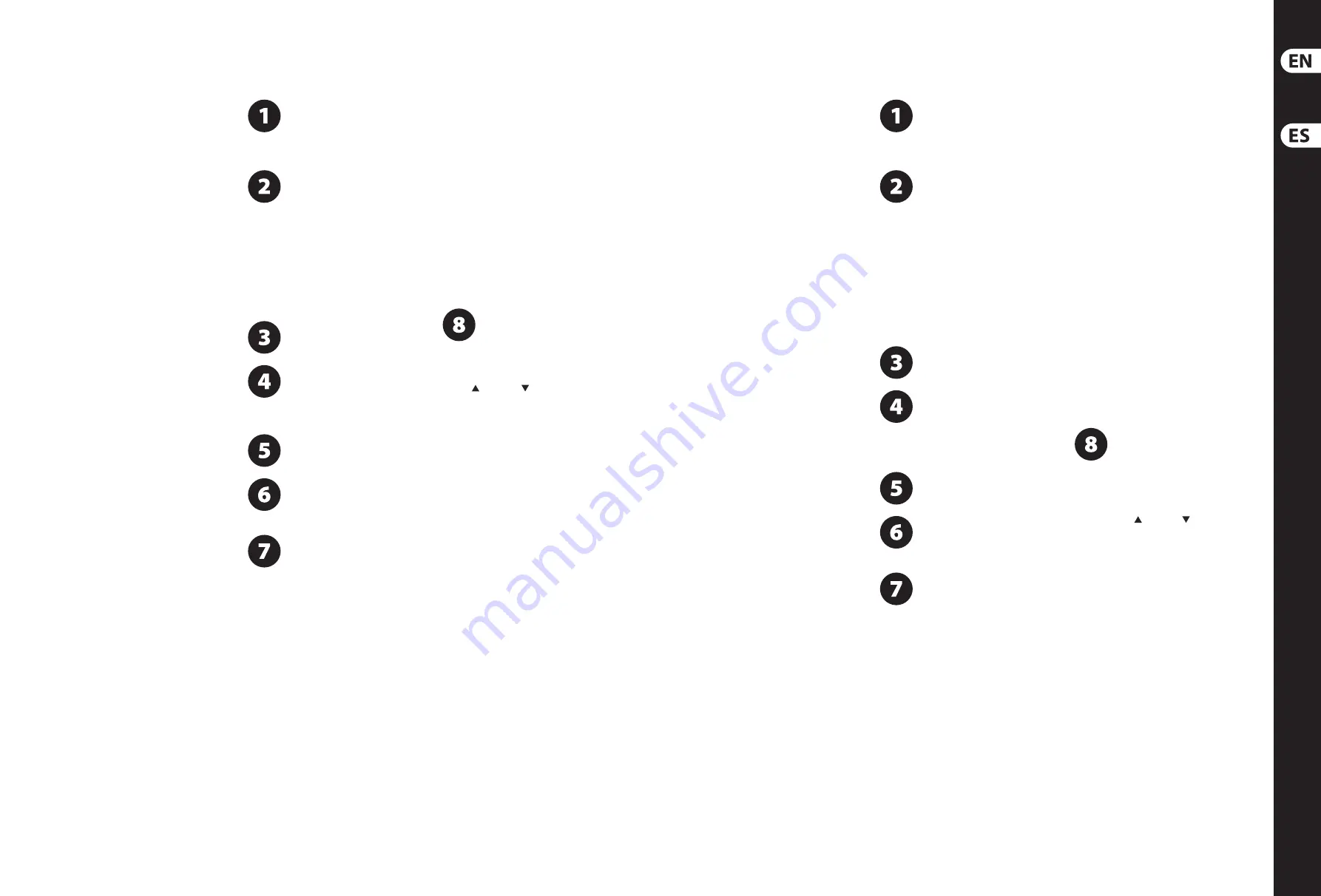
20
21
EUROPOWER PMP500
Quick Start Guide
Con todas las unidades apagadas, realice
todas las conexiones de corriente, audio y
de altavoces. Si está usando micrófonos
condensadores o unidades directas (DI box)
autoamplifi cadas, active el inter48 V.
Elija la confi guración de salida de
altavoces adecuada con el selector
AMP MAIN L/R – MON/MONO.
El EUROPOWER PMP500 tiene dos modos operativos
de la etapa de potencia. En el modo MAIN L/R,
el PMP500 actúa como un amplifi cador stereo.
En este modo, las señales stereo izquierda y
derecha son enviadas a las salidas OUTPUT A (L) y
OUTPUT B (R). En el modo MON/MONO, el PMP500
se comporta como un amplifi cador mono dual. En
este modo, la señal MONITOR es enviada a la salida
OUTPUT A y la señal principal o MAIN es enviada a
OUTPUT B.
Con los faders MAIN MIX L/R y de canal y
el mando de ganancia al mínimo,
encienda la unidad.
Suba los faders MAIN MIX L/R a la
posición “0” y ajuste después el volumen
de las fuentes audio conectadas por
medios de los faders de canal. Use el mando GAIN
para aumentar el nivel de la fuente de señal si
es necesario.
Ajuste la posición stereo izquierda /
derecha que quiera para cada canal con
los mandos PAN.
Suba el fader MON SEND hasta “0”.
Use los mandos MON de cada canal para
ajustar la cantidad del canal presente en
los monitores.
El PMP500 dispone de un procesador de
efectos interno. Siga estos pasos para
añadir un efecto a uno o más canales.
•
•
Gire el mando FX por encima de su punto medio
en cada uno de los canales en los que vaya a
aplicar el efecto.
•
•
Gire los mandos FX TO MON y FX TO MAIN más o
menos a la mitad y suba el fader FX SEND hasta la
posición “0”.
•
•
Desplácese por los distintos presets de efectos
usando el mando PROGRAM/VALUE y cuando
el preset que quiera aparezca en la pantalla
FX PROGRAM, pulse este mando PROGRAM/VALUE
para activar el preset.
•
•
Pulse el botón PARAMETER 1 / 2 para acceder
al modo de edición. El piloto del lado izquierdo
del botón PARAMETER 1 / 2 se iluminará para
indicarle que está activo el parámetro 1. Use
el mando PROGRAM/VALUE para ajustar el
parámetro. Pulse el botón PARAMETER 1 / 2
hasta que se ilumine el piloto del lado derecho
del botón PARAMETER 1 / 2, lo que indicará
que está activo el parámetro 2. Use entonces
el mando PROGRAM/VALUE para ajustar ese
segundo parámetro.
•
•
Pulse el botón PARAMETER 3 (TAP) para acceder
al modo de edición. Use el mando PROGRAM/
VALUE para ajustar el parámetro. Use el botón
PARAMETER 3 (TAP) si quiere ajustar el tempo de
los efectos temporizados rítmicamente.
•
•
Reajuste el mando FX de cada canal para
aumentar o reducir la cantidad de efectos
aplicada a la fuente de entrada de dicho canal.
Si se produce una realimentación,
active el sistema FBQ
FEEDBACK DETECTION.
•
•
Pulse los botones EQ y FBQ FEEDBACK
DETECTION para activar el sistema de detección
de realimentación.
•
•
Pulse el botón MAIN MIX / MONITOR para
asignar el EQ gráfi co a la salida MAIN o MONITOR.
•
•
Se iluminará un piloto en el mando deslizante del
EQ que se corresponda con la frecuencia que está
produciendo la realimentación.
•
•
Reduzca la posición del mando
deslizante del EQ iluminado hasta que la
realimentación desaparezca.
EUROPOWER PMP500 Getting started
With the power to all devices turned off ,
make all power, audio and speaker
connections. Engage the +48 V switch if
you are using condenser microphones or powered
direct boxes.
Select the appropriate speaker
output confi guration with the AMP MAIN
L/R – MON/MONO selector switch.
The EUROPOWER PMP500 has two power amp
operating modes. In MAIN L/R mode the PMP500
functions as a stereo amplifi er. In this mode left
and right stereo signals are sent to OUTPUT A (L) and
OUTPUT B (R). In MON/MONO mode the PMP500
functions as a dual mono amplifi er. In this mode the
MONITOR signal is sent to OUTPUT A and the MAIN
signal is sent to OUTPUT B.
With the MAIN MIX L/R faders,
channel faders, and gain knob turned
down, turn the mixer on.
Raise the MAIN MIX L/R faders to “0” and
then adjust the volume of connected
audio sources via each channel’s fader.
Use the GAIN knob to increase the level of the signal
source if necessary.
Adjust the desired left / right stereo
position of each channel with the
PAN knobs.
Raise the MON SEND fader to “0”.
Use each channel’s MON knobs to adjust
the amount of the channel present in the
monitor speaker(s).
The PMP500 has a built-in eff ects
processor. Follow these steps to add an
eff ect to one or more channels.
•
•
Turn the FX knob up half way on each channel
that the eff ect will be applied.
•
•
Turn the FX TO MON and FX TO MAIN knobs about
halfway up and raise the FX SEND fader to “0”.
•
•
Scroll through the FX presets using the
PROGRAM/VALUE knob, when the desired preset
number is designated in the FX PROGRAM display,
press the PROGRAM/VALUE knob to engage
the preset.
•
•
Press the PARAMETER 1 / 2 button to enter Edit
Mode. The LED on the left side of the PARAMETER
1 / 2 button will illuminate to indicate parameter
1 is active. Use the PROGRAM/VALUE knob to
adjust the parameter. Press the PARAMETER 1 / 2
button until the LED on the right side of the
PARAMETER 1 / 2 button illuminates. Use the
PROGRAM/VALUE knob to adjust the parameter.
•
•
Press the PARAMETER 3 (TAP) button to enter Edit
Mode. Use the PROGRAM/VALUE knob to adjust
the parameter. Use the PARAMETER 3 (TAP)
button to adjust the tempo of time-based eff ect.
•
•
Readjust each channel's FX knob to increase or
decrease the amount of eff ect applied to the
connected input source.
If feedback occurs,
engage FBQ
FEEDBACK DETECTION.
•
•
Press the EQ and FBQ FEEDBACK DETECTION
buttons to engage the feedback detection system.
•
•
Press MAIN MIX / MONITOR button to assign
the graphic EQ to either the MAIN or
MONITOR output.
•
•
An LED will illuminate on the EQ slider that
corresponds with the feedback frequency.
•
•
Lower the illuminated EQ slider until the
feedback stops.
(EN)
Step 3: Getting
started
(ES)
Paso 3: Puesta en
marcha
Содержание EUROPOWER PMP500
Страница 17: ...We Hear You...



































